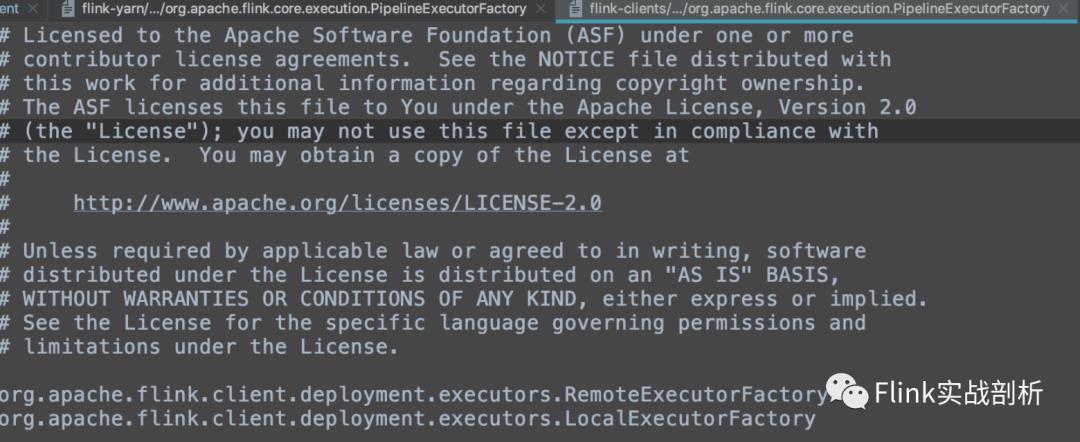FlinkFLink PipelineExecutorFactory 基于工厂模式的任务提交与SPI机制
Posted 九师兄
tags:
篇首语:本文由小常识网(cha138.com)小编为大家整理,主要介绍了FlinkFLink PipelineExecutorFactory 基于工厂模式的任务提交与SPI机制相关的知识,希望对你有一定的参考价值。

1.概述
转载: Flink1.10基于工厂模式的任务提交与SPI机制
Flink任务执行模式包含了yarn-session、standalone、per-job、local, 在1.10中又增加k8s的执行模式,那么在任务提交过程中如何根据不同的执行模式进行任务提交呢?
主要通过两个接口来实现:PipelineExecutorFactory 与 PipelineExecutor。PipelineExecutorFactory用于在不同模式下创建不同的PipelineExecutor, 用于提交任务,PipelineExecutorFactory表示的一个创建执行器工厂接口,PipelineExecutor 表示一个执行器接口,正如你所想这里使用的就是经典的工厂设计模式,在任务提交过程中会根据不同的提交模式, 使用不同的PipelineExecutorFactory创建不同的PipelineExecutor。
public interface PipelineExecutorFactory
/**
* Returns the name of the executor that this factory creates.
*/
String getName();
/**
根据configuration判断是否满足当前的factory
*/
boolean isCompatibleWith(final Configuration configuration);
/**
* 获取对应模式下的executor
*/
PipelineExecutor getExecutor(final Configuration configuration);
PipelineExecutorFactory几个实现分别为:
-
LocalExecutorFactory(local)
-
RemoteExecutorFactory(standalone)
-
YarnJobClusterExecutorFactory(per-job)
-
YarnSessionClusterExecutorFactory(yarn-session)

public interface PipelineExecutor
/**
* 执行任务
*/
CompletableFuture<JobClient> execute(final Pipeline pipeline, final Configuration configuration) throws Exception;
PipelineExecutor对应实现:
-
RemoteExecutor(standalone)
-
LocalExecutor(local)
-
YarnJobClusterExecutor(per-job)
-
YarnSessionClusterExecutor(yarn-session)

那么具体是如何选择factory呢?由PipelineExecutorServiceLoader接口来完成,其只有一个实现类DefaultExecutorServiceLoader, 透过命名你可能会才想到这里面用到了ServiceLoader,你的猜想是正确的,它就是通过SPI机制去加载flink所提供的不同factory,在META-INF.services 下可以找到其对应的配置:

DefaultExecutorServiceLoader.java部分源码
//SPI机制
private static final ServiceLoader<PipelineExecutorFactory> defaultLoader = ServiceLoader.load(PipelineExecutorFactory.class);
//获取对应的factory
public PipelineExecutorFactory getExecutorFactory(final Configuration configuration)
checkNotNull(configuration);
final List<PipelineExecutorFactory> compatibleFactories = new ArrayList<>();
final Iterator<PipelineExecutorFactory> factories = defaultLoader.iterator();
while (factories.hasNext())
try
final PipelineExecutorFactory factory = factories.next();
//判断标准 根据任务启动配置
if (factory != null && factory.isCompatibleWith(configuration))
compatibleFactories.add(factory);
catch (Throwable e)
if (e.getCause() instanceof NoClassDefFoundError)
LOG.info("Could not load factory due to missing dependencies.");
else
throw e;
//只能有一个factory符合要求
if (compatibleFactories.size() > 1)
final String configStr =
configuration.toMap().entrySet().stream()
.map(e -> e.getKey() + "=" + e.getValue())
.collect(Collectors.joining("\\n"));
throw new IllegalStateException("Multiple compatible client factories found for:\\n" + configStr + ".");
return compatibleFactories.isEmpty() ? null : compatibleFactories.get(0);
ServiceLoader.load(PipelineExecutorFactory.class) 会从类路径的META-INF.services下找到PipelineExecutorFactory的全路径文件,然后实例化出所有的factory,通过PipelineExecutorFactory.isCompatibleWith找到匹配的factory。
此处的PipelineExecutor体系参考:【Flink】Flink PipelineExecutor 体系
以上是关于FlinkFLink PipelineExecutorFactory 基于工厂模式的任务提交与SPI机制的主要内容,如果未能解决你的问题,请参考以下文章